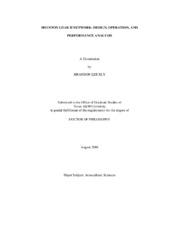| dc.contributor.advisor | Orville, Richard E. | |
| dc.creator | Ely, Brandon Lee | |
| dc.date.accessioned | 2008-10-10T20:59:15Z | |
| dc.date.available | 2008-10-10T20:59:15Z | |
| dc.date.created | 2008-08 | |
| dc.date.issued | 2008-10-10 | |
| dc.identifier.uri | https://hdl.handle.net/1969.1/85993 | |
| dc.description.abstract | The Houston LDAR II network is an array of twelve VHF time-of-arrival (TOA)
sensors operated by Texas A&M University. The goals of the network are to conduct indepth
studies of thunderstorm electrification and provide timely lightning threats to the
Houston area. Before analyses are conducted using data from the Houston LDAR
network, it is necessary to understand the LDAR networkâ s performance and limitations,
such as the LDAR source detection efficiency, network range, and location accuracy.
Initial results from the 31 October 2005 Mesoscale Convective System (MCS)
timing error analysis revealed an RMS timing error for the Houston LDAR network of
90 ns for 6 sensor solutions. This gives a three-dimensional location accuracy of 1 km at
a distance of 150 km and 100 m over the center of the network. Reanalysis with updated
sensor positions decreased the RMS timing error to 75 ns. This decrease in RMS timing
error increased the median three-dimensional location accuracy by ~100 m at a 100 km
range. The network has been operated at both 70 MHz and 40 MHz. Model results of
detection efficiency suggest that the change to 40 MHz yields an increase of 9 - 10 dB in
network sensitivity. Analysis of VHF source power distributions shows a similar shift
from that expected from the model. These results show that the 40 MHz LDAR network
detects ~3.3 times more VHF sources than the 70 MHz network.
The analysis of the usable network range for research purposes is currently set by
rough guidelines of location accuracy and detection efficiency. For location accuracy, a
1 km limit allows storm analysis out to a range of more than 150 km. For the detection
efficiency analysis, results based on source power distributions suggest a gradual fall off
with range. Examining the change in VHF source density by range reveals different
results. VHF source density remained fairly constant out to a range of 100 km at which
point a significant fall off was observed. Based on these results the usable network
range for the Houston network is 100 km. | en |
| dc.format.medium | electronic | en |
| dc.language.iso | en_US | |
| dc.publisher | Texas A&M University | |
| dc.subject | Cloud Physics | en |
| dc.subject | Electrification | en |
| dc.subject | Lightning | en |
| dc.subject | Lightning Detection | en |
| dc.title | Houston LDAR II network: design, operation, and performance analysis | en |
| dc.type | Book | en |
| dc.type | Thesis | en |
| thesis.degree.department | Atmospheric Sciences | en |
| thesis.degree.discipline | Atmospheric Sciences | en |
| thesis.degree.grantor | Texas A&M University | en |
| thesis.degree.name | Doctor of Philosophy | en |
| thesis.degree.level | Doctoral | en |
| dc.contributor.committeeMember | Kattawar, George | |
| dc.contributor.committeeMember | Schumacher, Courtney | |
| dc.contributor.committeeMember | Carey, Lawrence D. | |
| dc.type.genre | Electronic Dissertation | en |
| dc.type.material | text | en |
| dc.format.digitalOrigin | born digital | en |


